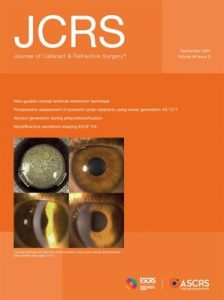
JCRS 2020
JCRS highlights
Aerosol and phaco safety
There is surprisingly little data on aerosols generated during phacoemulsification cataract surgery. Researchers in the UK have performed an ex vivo study looking at the size and number of particles generated by phacoemulsification. Using an TROTEC PC200 optical particle counter, they measured particles generated during continuous power mode: 80% longitudinal setting, 100% torsional setting, and 80% longitudinal setting. The study found no aerosol generation of particles ≤10μm during phacoemulsification for any of the three settings evaluated. The copious use of hydroxypropyl methylcellulose did not have an effect on aerosol generation. They conclude that phacoemulsification does not appear to be a small-particle aerosol-generating procedure. However, they note further in vivo and ex vivo studies using different aerosol counting methods are needed.
H Lee et al., JCRS, “Aerosol generation through phacoemulsification”, Vol. 46, #9, 1290-96.
EDOF after myopic LASIK?
IOL calculation in patients who have previously undergone laser in situ keratomileusis (LASIK) continues to challenge cataract surgeons. Newer formulas have improved visual results, but outcomes are often inferior compared with untreated eyes. German researchers evaluated IOL calculation formulas provided by the ASCRS online tool (http://iolcalc.ascrs.org/) for an extended depth-of-focus (EDOF) IOL after previous myopic LASIK. The retrospective study included 25 eyes, all of which received the Tecnis Symfony IOL (Abbott Medical Optics Inc.) during femtosecond laser-assisted cataract surgery. Formulas evaluated included Shammas, Haigis-L, average, Barrett True-K, modified Masket, Barrett No History and Masket. Of these, the Shammas and Haigis-L formulas had the most eyes within ±0.5D of target refraction with 52% and 48% respectively. The researchers note the need for lens constant optimisation and improvement of measurements, especially of the cornea, and new formulas to achieve better results and higher predictability in patients after refractive surgery.
C Lwowski et al., JCRS, “Prediction accuracy of IOL calculation formulas using the ASCRS online calculator for a diffractive extended depth-of-focus IOL after myopic laser in situ keratomileusis”, Vol. 46, #9, 1240-6.
Anterior segment OCT and posterior polar cataracts
Anterior segment OCT can help define posterior opacity-capsular morphology preoperatively, which should help to reduce complications associated with posterior polar cataracts, report researchers. A team in New Delhi used the newer-generation AS-OCT, CASIA-2 (Tomey Corp.) system to evaluate 101 eyes diagnosed with posterior polar cataracts. They observed that deficient capsular morphology in posterior polar cataracts is likely to show different patterns depending on the type and extent of capsule loss with opacity localisation. They report that specific capsular morphologies could be categorised into conical, moth-eaten and ectatic types. They suggest that these findings could result in better case management.
A Pujari et al., JCRS, “Study 1: Evaluation of the signs of deficient posterior capsule in posterior polar cataracts using anterior segment optical coherence tomography”, Vol. 46, #9, 1260-65.

 JCRS 2020
JCRS 2020